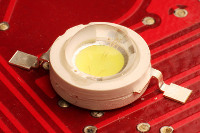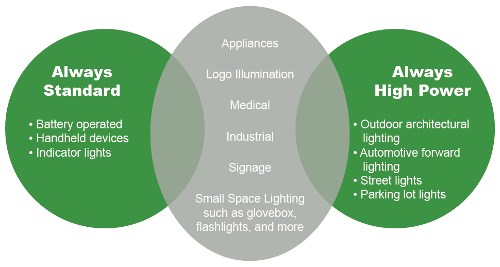 |
| January 29, 2013 | Volume 09 Issue 04 |
Designfax weekly eMagazine
Archives
Partners
Manufacturing Center
Product Spotlight
Modern Applications News
Metalworking Ideas For
Today's Job Shops
Tooling and Production
Strategies for large
metalworking plants
Shedding some light on selecting standard vs. high-power LEDs
By Dwight Turner, Technology Design Specialist, Lumex, and
Cliff Ortmeyer, Technical Marketing, Newark element14

It is human nature for designers to be attracted to the bright, new shiny objects of the day, which within the context of this article could be seen as high-power (HP) or high-brightness LEDs. Unquestionably, HP LEDs can offer advantageous benefits in terms of lighting performance, energy efficiency, durability, and cost savings, and they have definitely invigorated the lighting industry, offering innovative solutions for applications ranging from streetlamps to the stage.
They are, however, not always your best choice for every lighting technology application.
In fact, there are many situations where standard LEDs (with a 20-150mA draw) or mid-power LEDs (drawing between .25 and .5W) can provide comparable brightness performance, while generating significant cost and design benefits.

1W HP (left) vs. five-LED standard array (magnified to show package type).
By way of example, let's say you have an application that requires 70lm of light output or brightness. You can achieve this output by either using a single 1W HP LED or an array of five 5mm standard LEDs. The high-power LED on the left draws 3.5V at a peak current draw of 500mA and a steady current of approximately 350-400mA. By contrast, the standard-power LEDs on the right operate at 3 to 3.5V at a peak current of 100mA, with steady current of 20mA.
Explanation 1: Luminous Output for both designs 70lm
High Power LED (total power): 350ma-400ma steady x 3.5V = 1.225W - 1.4W range or approx. 1.3W
Standard Power LEDs (total power): 5 LEDs x 20ma steady x 3.5V(max) = 0.35W
(Note 500mA for High Power and 100mA for Standard Power LEDs are intended for pulsing applications, not steady state)
Thus, the power consumption of the Higher Power LED design is 3-4 times greater than the Standard Power LED design.
Explanation 2: Luminous Output for both designs 70lm
High Power LED: 3.0V - 3.5V
Standard Power LEDs: 3.2V - 3.5V
Which path to choose? There are three main considerations to address to help you make the best decision.
Consider the design process
The design process required for a standard LED array can be far simpler than that which is required for a high-power technology, based on differing thermal management requirements. In the above example, the 1W LED will be driven at 400mA of current, compared to just 100mA for the array of five standard LEDs.
To achieve this, the high-power technology will require a heat sink and metal core PCB board to ensure that the junction temperature is not high enough to result in a loss in efficacy, decrease in life hours, or color degradation. Standard LEDs do not require heat sinks, a metal core PCB board, drivers, capacitors, or resistors, making them easier to design, test, and manufacture.
These factors alone do not necessarily negate the use of the high-power alternative, as the complexity of the design needs to be balanced with space and cost demands.
Consider the space requirements
As mentioned, an array of standard LEDs can provide the same brightness as a HP LED. It can also provide space savings of up to 50 percent, as it does not require bulky cooling technology to prevent overheating, nor space-consuming drivers, capacitors, and resistors.
Consider the cost savings
While a 1W HP LED can output more than 80 lumens as compared to a standard LED's output of 20,000 mcd, the high-power LED generates more heat (a maximum junction of 125 deg C) and can increase power consumption by 90 percent. Without proper heat management, the lifetime, product functionality, performance, and material can be compromised. The most costly design addition is the heat sink, which can add $1 to $10 to the cost, depending on the kind of material used.
Explanation:
High Power LED optical output: 80 lm[nr]
Standard Power LEDs (5 x 20,000 mcd): 100,000 mcd @60-90 deg (array) --> approx. 75-80 lm
Similarly, the use of a metal-cored PCB to serve as another cooling technique to control junction temperature is five times more costly than the PCB typically required by standard LEDs.
When the choice is clearer
There are times when it is much easier to figure out which technology is best suited to a particular application. Smaller battery-operated or portable consumer electronic devices, accent lighting, and standard indicator lights have long used standard LEDs and are likely to continue to do so. Then too, anywhere there are concerns about PCB space limitations or the potential for LED intensity bleed within a particular design, the use of standard LEDs is indicated.
Conversely, general outdoor lighting, large-area indoor lighting (track lighting, bulb replacement), and automotive lighting will continue to use HP LED technology. HP LEDs allow for measured scalability and design flexibility -- plus, they fit well into sustainability programs, offer competitive solutions for every market, and offer life spans that can reach 50,000 to 70,000+ life hours.

[Source: Lumex]
When the choice is grayer
There are many applications that fall into the gray area, where low-power and high-power options could both fit the bill. Making that decision requires still further considerations.
Consider the minimum/maximum intensity output required. Is this a flood area or more constrained use of lighting, as in a retail setting where focused lights draw the eye to a specific item or theme? In constrained spaces such as a cupholder in a car or a water dispenser in a refrigerator that require a smaller footprint bulb, multiple standard LEDs in a circular array are ideal.
Consider how much power will be available. Is the power supply a battery implementation or microcircuit with less than 1W at approximate capability? If so, a standard LED implementation is most practical. Energy-saving designs also match well with standard-power implementation, with the exception of flash technology in portable designs where mid-power LEDs are pulsed. If the energy budget allows for the inclusion of driver ICs, power supplies, and design topology offering greater than 1W output with greater than 150-200mA of current available, then HP LEDs can be considered for the solution.
General temperature considerations discussed in the first example also apply here.
Consider your budget. What is the ideal cost range for the overall system? Many designs can be implemented with multiple standard-power LEDs at a significant cost savings as compared to a HP LED alternative. Designers need to consider the cost per lumen in implementing larger lighting solutions and factor in the overall cost of heat dissipation, circuit topology, and design complexity in their overall budget.
Consider the space constraints. The space on the board and the space to be illuminated should be considered in picking the optics of the LED devices. Does the design require special lensing or optics to achieve the distributed or focused light required by the end application? Could the design use through-hole standard LEDs with narrow angle patterns to give a tight and concentric lighting area? Or could standard mid-power or high-power surface-mount devices be used to give wider illumination angles?
The size of the area to illuminate comes into play as well. In smaller devices, like a wine cooler, a few HP LEDs in a bar arrangement could provide lighting if the appropriate lensing, housing, and power circuitry are used. Then again, multiple through-hole or surface-mount LEDs in an array or separate bars could also accomplish the lighting design. These factors must be weighed against the component technology, LED placement, and housing considerations.
The location of the application can also play a role in the decision-making process. Taking a real-life example, we were working with a leading industrial manufacturer to re-evaluate a lighting solution for the inside cabin of the area. The original design called for three HP 1W LEDs in order to meet a specific brightness level. Lumex provided an alternative solution by offering an array of 18 standard high-brightness 5mm LEDs with special lensing which not only met the lighting requirement, it assured that no heat would be generated in the cabin and provided a 50 percent cost savings.
The final consideration? When you're in doubt, call upon the expertise of your lighting supplier or distributor for technical information and support. They have knowledge and experience to put your design in the best light.
For more information, visit www.newark.com/lighting or www.lumex.com. For technical support, contact Newark element14 at 877.736.4835 or Lumex at 800.278.5666.
Published January 2013
Rate this article
View our terms of use and privacy policy
